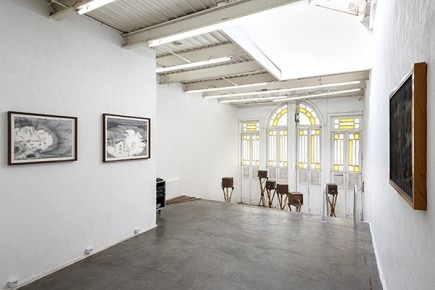Febre Amarela
Vivian Caccuri
21 Sep - 01 Nov 2019
FEBRE AMARELA
Vivian Caccuri
21 September – 1 November 2019
In Febre Amarela, Vivian proposes a new environmental relationship with mosquitoes. The mosquito, which has been the pivot of the largest epidemics in Brazil throughout its history – yellow fever, dengue fever, zika -, is once again at the center of anguish, fears, urban and environmental crises, either as an inevitable result of deforestation or as an almost unquestionable way of life in the big Brazilian cities.
However, in Febre Amarela the Brazilians are a new culture that have overcome their fear of mosquitoes – starting with their annoying noise, overcoming disease and learning how to deal with these insects in a new world overrun by them, developing a new immunity.For building no. 17 of the gallery, the artist has created fictions and reflects on the historical roots of the American mosquito population, showing the works Sesmaria Soundsystem and Templo do Mosquito (Mosquito Temple).
Realizing that the first epidemics of yellow fever and mosquito-borne diseases had their epicenter in the colonial sugar economy, the artist and her team developed a rapadura soundsystem that echoes the annoying sound of mosquitoes, accompanied by typical sugarcane foliage and burning, and the mestizo flutes called “pife” that arose at the same time. Sesmaria Soundsystem is a reinterpretation of the rapadura material for sound reproduction media.
The Templo do Mosquito, a 230cm by 405cm mosquito net that participated in the Kochi Biennale in India, shows the encounter of mosquito sex with different manifestations of the human body: the mosquito is one of the designers of what we understand by humanity.
Throughout the exhibition there are landscape drawings, with extras who loom lost over this destroyed and modified nature: Brumadinho, Mariana, are scenes from the latest Brazilian landscape, now more striking than its vibrant and dense nature. Yet the subjects still live and prosper in their own way, as has always occurred in the history of Brazil.
The pagodas, an important part of Vivian Caccuri’s work for some years now, are present in yellow for the first time, alluding to the feverish state of this colonial disease that returns in times of national crisis. The material, a plastic screen that protects against particles and insects, is also present in the most disruptive part of Febre Amarela, “RAPADURA: a collection developed in partnership with Victor Apolinário, that will be presented in a fashion show and sold in a pop-up store assembled inside the gallery space.
Febre Amarela is a narrative that is optimistic in chaos, where the neo-Brazilian assimilates the political polarization, returns to craft culture in a technological way and acquires knowledge from various sources for self-protection.
Vivian Caccuri
21 September – 1 November 2019
In Febre Amarela, Vivian proposes a new environmental relationship with mosquitoes. The mosquito, which has been the pivot of the largest epidemics in Brazil throughout its history – yellow fever, dengue fever, zika -, is once again at the center of anguish, fears, urban and environmental crises, either as an inevitable result of deforestation or as an almost unquestionable way of life in the big Brazilian cities.
However, in Febre Amarela the Brazilians are a new culture that have overcome their fear of mosquitoes – starting with their annoying noise, overcoming disease and learning how to deal with these insects in a new world overrun by them, developing a new immunity.For building no. 17 of the gallery, the artist has created fictions and reflects on the historical roots of the American mosquito population, showing the works Sesmaria Soundsystem and Templo do Mosquito (Mosquito Temple).
Realizing that the first epidemics of yellow fever and mosquito-borne diseases had their epicenter in the colonial sugar economy, the artist and her team developed a rapadura soundsystem that echoes the annoying sound of mosquitoes, accompanied by typical sugarcane foliage and burning, and the mestizo flutes called “pife” that arose at the same time. Sesmaria Soundsystem is a reinterpretation of the rapadura material for sound reproduction media.
The Templo do Mosquito, a 230cm by 405cm mosquito net that participated in the Kochi Biennale in India, shows the encounter of mosquito sex with different manifestations of the human body: the mosquito is one of the designers of what we understand by humanity.
Throughout the exhibition there are landscape drawings, with extras who loom lost over this destroyed and modified nature: Brumadinho, Mariana, are scenes from the latest Brazilian landscape, now more striking than its vibrant and dense nature. Yet the subjects still live and prosper in their own way, as has always occurred in the history of Brazil.
The pagodas, an important part of Vivian Caccuri’s work for some years now, are present in yellow for the first time, alluding to the feverish state of this colonial disease that returns in times of national crisis. The material, a plastic screen that protects against particles and insects, is also present in the most disruptive part of Febre Amarela, “RAPADURA: a collection developed in partnership with Victor Apolinário, that will be presented in a fashion show and sold in a pop-up store assembled inside the gallery space.
Febre Amarela is a narrative that is optimistic in chaos, where the neo-Brazilian assimilates the political polarization, returns to craft culture in a technological way and acquires knowledge from various sources for self-protection.

